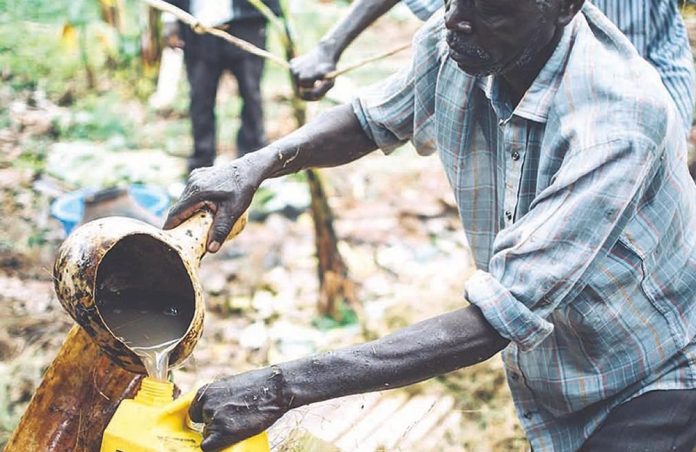Mwenge Bigele! Get drunk on a ripe banana beverage, or just bask in the glory that is the Buganda culture. As its name suggests, the brewing process involves stepping. Mwenge is alcohol, Bigere is feet. But first, let me tell you about Ssalongo Kasanvu Kakeeto.
We met at the Buganda Tourism Expo where he had gone to exhibit Mwenge Bigere. However, something stood out that would soon switch our conversation from the drink to a thing. Eryato, which is its Kiganda name, is a very fascinating artifact.
A wooden boat-like article designed for brewing. Inside it, ripe bananas were mashed dutifully with bare feet till they morphed into overflowing sweet juice. The juice, then, would be fermented and turned into Tonto or Mwenge Bigere: the local brew. It’s one of the best brews ever invented by man. It’s strong, indigenous, sweet, and too hard a drink capable of flooring a grownup man.
These boats are still in existence in the rural areas even when the world moved on. Civilization is cutting through the rural areas like cancer, but these boats have remained. Nowadays, many families in the villages own them. This wasn’t the case in the yesteryears, especially among Buganda. It was exclusive to a few. The very rich to be exact. This begs the question, why? “This is because the process of making it was very demanding, both in terms of time and resources,” Kakeeto offered.
According to the Senior Administrator with Mutima Club, an association at the forefront of preserving Buganda’s cultures, it would start by felling down a mature hard-wood tree with a thick stem. Canarium Schwinfurthii, locally known as the Mpafu tree was of stronger preference as it never cracks even when over-exposed to sunshine.
Thusly, it stands the test of time. Using heavy-duty traditional tools especially axes and pangas, a craftsman with a reputation for paying attention to detail would shove a hole inside the tree, expertly, attentively yet artistically. The edges were/are sliced off and molded nicely. It is then smoothened on the surface. He would continue shoveling to create a hollow section with a wide base and narrow entrance. “That way, the stomp wouldn’t flow over when being mashed using the feet.” He says
Finally, a huge chunk is yanked out, leaving it (boat) somewhat hollow. It’s in that hole that the ripe bananas are later thrown and mashed with sorghum, a core ingredient of the beer. On the other hand, the outside skin would be repeatedly scrapped to give it a more appealing look. The outcome of this hard work was light and impressive boat edged by two handles known as Ensanda for easy mobility.
“Due to this complexity that comes with making it, only a few used to have it. In many instances, a village would have less than two.” As such, sharing was the way to go. This spirit of sharing created unbeaten solidarity among locals. In appreciation, the party who had borrowed would reward its owner with a reasonable portion of the final fruitage.
This attracted a great deal of respect. The ground upon which it was laid for mashing was always carpeted with banana leaves and stem. Partly, this practice was meant to lessen its wear and tear. At the end of the day, it would be kept on an elevated stand like a souvenir. From time to time, its outer wall would be smeared with cow dung for preservation. On the other hand, its inside was preserved using sup from the very bananas mashed inside.
Taboos
Granted both sexes were free to savor its rich taste, but it was abominable for the female to participate in certain phases of its making. Such included the mashing phase. According to Mwami Ssonko Emmanuel, Secretary Njonge Clan, the exclusivity to men was because women don’t have as much strength as men.
They agreed that mashing the bananas required so much strength. “Short of that, it is bound to go bad in less than a few days or even hours.” he worries. That aside, many didn’t feel comfortable having women take charge of the process as they might do so while in their periods. Sexist as this was, they argued that they didn’t want to risk contaminating the drink.










